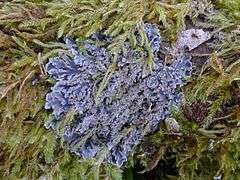Pannariaceae
The Pannariaceae are a family of lichens in the order Peltigerales (suborder Collematineae). Species from this family have a widespread distribution, but are especially prevalent in southern temperate regions.[1]
| Pannariaceae | |
|---|---|
 | |
| Pannaria conoplea, in Pont-Neuf, France | |
| Scientific classification | |
| Kingdom: | Fungi |
| Division: | Ascomycota |
| Class: | Lecanoromycetes |
| Order: | Peltigerales |
| Family: | Pannariaceae Tuck. (1872) |
| Type genus | |
| Pannaria Delise ex Bory (1828) | |
Genera
According to a recent (2020) estimate, the family contains 27 genera and about 360 species. The following list indicates the genus name, the taxonomic authority, year of publication, and the number of species:[2]
- Austrella P.M.Jørg. (2004)[3] – 3 spp.
- Degelia Arv. & D.J.Galloway (1981) – 16 spp.
- Erioderma Feé (1825) – 32 spp.
- Fuscoderma (D.J.Galloway & P.M.Jørg.) P.M.Jørg. & D.J.Galloway (1989) – 5 spp.
- Fuscopannaria P.M.Jørg. (1994) – 58 spp.
- Gibbosporina Elvebakk, S.G.Hong & P.M.Jørg. (2016) – 13 spp.
- Homothecium A.Massal. (1853) – 4 spp.
- Joergensenia Passo, S.Stenroos & Calvelo (2008) – 1 sp.
- Leciophysma Th.Fr. (1865) – 2 spp.
- Leightoniella Henssen (1965) – 1 sp.
- Leioderma Nyl. (1888) – 7 spp.
- Lepidocollema Vain. (1890) – 22 spp.
- Leptogidium Nyl. (1873) – 3 spp.
- Nebularia P.M.Jørg. (2014)[4] – 2 spp.
- Nevesia P.M.Jørg, L.Lindblom, Wedin & S.Ekman (2014)[4] – 1 sp.
- Pannaria Del. ex Bory (1828) – ca. 40 spp.
- Parmeliella Müll.Arg. (1862) – ca. 40 spp.
- Pectenia P.M.Jørg. (2014)[4] – 4 spp.
- Physma A.Massal. (1864) – 12 spp.
- Protopannaria (Gyeln.) P.M.Jørg. & S.Ekman (2000) – 7 spp.
- Psoroma Michaux (1803) – ca. 70 spp.
- Psoromaria Nyl. ex Nyl. (1891) – 2 spp.
- Psoromidium Stirt. (1877) – 2 spp.
- Ramalodium Nyl. (1879) – 6 spp.
- Siphulastrum Müll.Arg. (1889) – 4 spp.
- Staurolemma Körb. (1867) – 3 spp.
- Steineropsis T.Sprib. & Muggia (2010)[5] – 1 spp.
gollark: It's *probably* fixable.
gollark: No, they're going to award GCSEs and stuff based on... guesswork, and also previous results in stuff.
gollark: All the exams.
gollark: Or... would have, but it was cancelled.
gollark: We get them in all our maths exams except one of the further maths papers.
References
- Cannon PF, Kirk PM (2007). Fungal Families of the World. Wallingford: CABI. p. 254. ISBN 0-85199-827-5.
- Wijayawardene, Nalin; Hyde, Kevin; Al-Ani, LKT; S, Dolatabadi; Stadler, Marc; Haelewaters, Danny; et al. (2020). "Outline of Fungi and fungus-like taxa". Mycosphere. 11: 1060–1456. doi:10.5943/mycosphere/11/1/8.
- Jørgensen, P.M. (2004). "Further contributions to the Pannariaceae (lichenized Ascomycetes) of the Southern Hemisphere". Bibliotheca Lichenologica. 88: 229–253.
- Ekman, Stefan; Wedin, Mats; Lindblom, Louise; Jørgensen, Per M. (2014). "Extended phylogeny and a revised generic classification of the Pannariaceae (Peltigerales, Ascomycota)". The Lichenologist. 46 (5): 627–656. doi:10.1017/S002428291400019X.
- Spribille, Toby; Pérez-Ortega, Sergio; Tønsberg, Tor; Schirokauer, Dave (2010). "Lichens and lichenicolous fungi of the Klondike Gold Rush National Historic Park, Alaska, in a global biodiversity context". The Bryologist. 113 (3): 439–515. doi:10.1639/0007-2745-113.3.439.
This article is issued from Wikipedia. The text is licensed under Creative Commons - Attribution - Sharealike. Additional terms may apply for the media files.